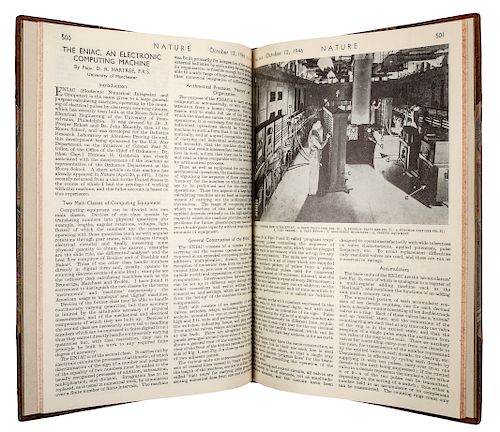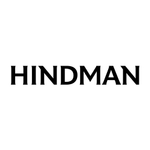HARTREE, Douglas R. (1897-1958). "The ENIAC, an Electronic Calculating Machine." In: Nature, Vol. 157, No. 3990, p. 527. London: Macmillan and Co.,
Lot 36
About Seller
Hindman
1338 West Lake Street
Chicago, IL 60607
United States
Recognized as the Midwest's leading fine art auctioneers, Hindman Auctioneers has built a worldwide reputation based on a full service approach to the auction business tailored to meet the individual needs of our clients. Coming from a variety of educational backgrounds, specialists bring years of e...Read more
Categories
Estimate:
$1,000 - $1,500
Absentee vs Live bid
Two ways to bid:
- Leave a max absentee bid and the platform will bid on your behalf up to your maximum bid during the live auction.
- Bid live during the auction and your bids will be submitted real-time to the auctioneer.
Bid Increments
| Price | Bid Increment |
|---|---|
| $0 | $25 |
| $500 | $50 |
| $1,000 | $100 |
| $2,000 | $250 |
| $5,000 | $500 |
| $10,000 | $1,000 |
| $20,000 | $2,500 |
| $50,000 | $5,000 |
| $100,000 | $10,000 |
About Auction
By Hindman
Nov 5, 2019
Set Reminder
2019-11-05 11:00:00
2019-11-05 11:00:00
America/New_York
Bidsquare
Bidsquare : Library of a Midwestern Collector
https://www.bidsquare.com/auctions/hindman-auctions/library-of-a-midwestern-collector-4496
Hindman Bidsquare@hindmanauctions.com
Hindman Bidsquare@hindmanauctions.com
- Lot Description
[ENIAC]. HARTREE, Douglas R. (1897-1958). “The ENIAC, an Electronic Calculating Machine.” In: Nature, Vol. 157, No. 3990, p. 527. London: Macmillan and Co., April 20, 1946. – HARTREE. “The ENIAC, An Electronic Computing Machine.” In: Nature, Vol. 158, No. 4015, pp. 500-506. London: Macmillan and Co., October 12, 1946.
Together 2 works in one volume, 8vo. With 4 plates (one folding). (Occasional light foxing.) Modern half calf. Provenance: The Drackett Co. (received stamp on volume title dated “Sep 25 1946”).
THE FIRST WIDELY PUBLISHED ANNOUNCEMENT AND DESCRIPTION OF THE ENIAC--THE FIRST ELECTRONIC DIGITAL COMPUTER. The brief first paper begins: “The news has recently been released of a major advance in the development of equipment for extensive numerical calculations, in the successful completion of a large calculating machine based on the use of electronic counting circuits…”. The ENIAC was first unveiled to the public on February 14, 1946 at the Moore School of the University of Pennsylvania, but a published announcement and detailed description of the new computer was not issued until the appearance of these two articles in Nature.
“The ENIAC, developed during World War II by Pres Eckert and John Mauchly at the University of Pennsylvania's Moore School of Engineering, was the world's first large-scale general purpose digital computer. Hartree, a British mathematician, first learned of ENIAC in 1945, when he saw the as-yet uncompleted machine during a visit to the Moore School. In 1946 he returned to the Moore School as a participant in the Moore School lectures, advising on nonmilitary uses of ENIAC; during this time he became the first Englishman to work with the machine. He was the first to bring news of ENIAC to Great Britain, publishing the above article in Nature shortly after his return from the United States. Although he himself invented no new calculating devices, Hartree's promotion of electronic digital calculating methods in scientific computation helped to stimulate the development of more powerful computers like Cambridge University's EDSAC” (Norman). Origins of Cyberspace 648 (second paper).
For condition inquiries please contact Gretchen Hause at gretchenhause@hindmanauctions.comCondition
- Shipping Info
-
Please refer to https://hindmanauctions.com/shipping-packing
-
- Buyer's Premium



 EUR
EUR CAD
CAD AUD
AUD GBP
GBP MXN
MXN HKD
HKD CNY
CNY MYR
MYR SEK
SEK SGD
SGD CHF
CHF THB
THB













